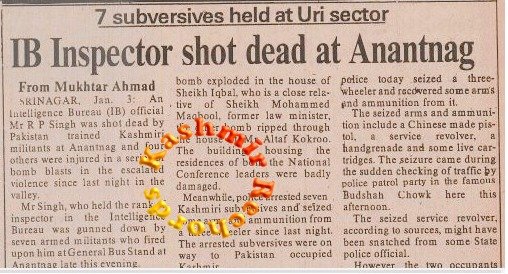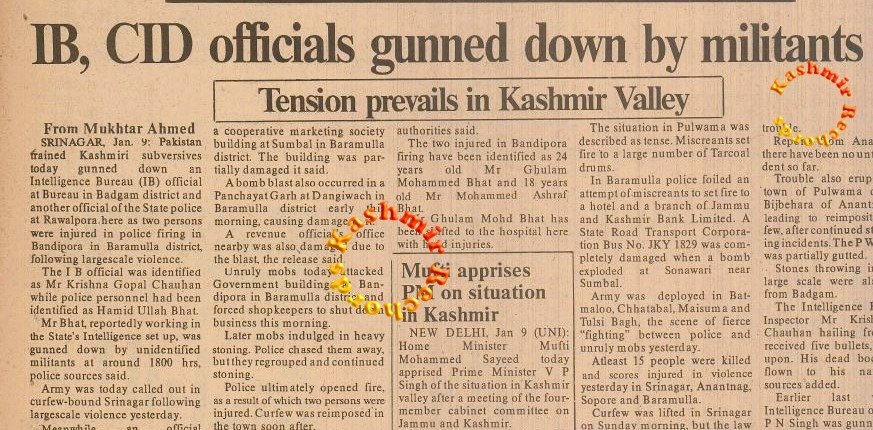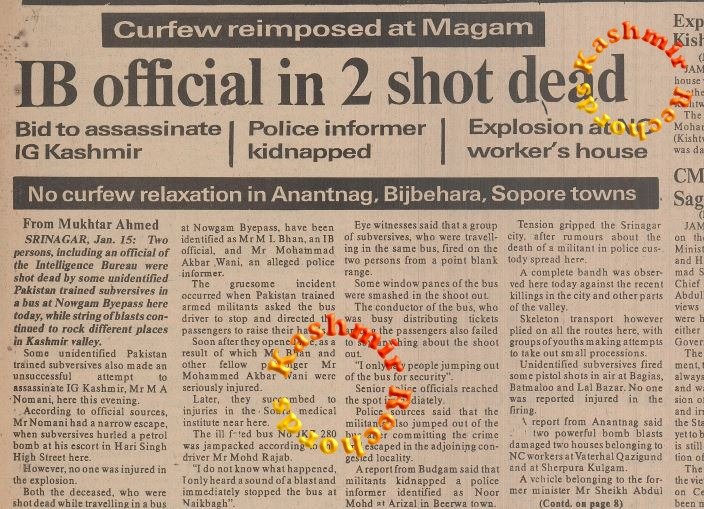(Kashmir Rechords Exclusive)
The Intelligence Bureau (IB), India’s internal intelligence agency, reputed to be the oldest such organization had suffered major causalities in Kashmir Valley in 1990, beginning from January 2. On January 27, when the world observes International Holocaust Remembrance Day, it is an opportunity to reassert Nation’s commitment to human rights and to commemorate the sacrifices of its intelligence officials that are not discussed in the public domain. The intelligence inputs provided by these unsung heroes are vital for the nation’s security and protection. Therefore, it is important for their sacrifices to be recognised and honoured.

There are many heart-wrenching stories of officials of the Intelligence Bureau (IB) who made supreme sacrifice in the line of duty while exposing the Pakistan-sponsored terrorism in Jammu and Kashmir. Their sacrifices may have remained hidden from the public eye to ensure the secrecy of the organisation. But it is necessary to tell the present generation all that what had happened during the initial phase of militancy in Kashmir.
Beeru town in the Budgam district of Kashmir, was known to be a stronghold of the fundamentalist militant groups. That is why the work done by Krishan Gopal Chouhan, 37, a Sub-Inspector of the Intelligence Bureau (IB) was considered valuable.
Chouhan ran a one-man operation in this town. His success had already been noticed by the militants. On January 8, 1990, his luck ran out. A man in the Pheran was stalking Chouhan in the bustling street of Beeru. He pulled out a Kalashnikov from his Pheran and shot IB Official five times.
A few hours after Chouhan’s death, terrorists had struck again. This time killing Inspector Hameedullah Bhat of the State’s counter-espionage cell in Srinagar’s Rawalpora locality. Bhat was the fourth state intelligence man killed by terrorists. Since September 1989, militants had killed several civilians also, accused them of being informers.

With the death of Chouhan, the IB had lost its second field operative within a week. Earlier, on January 2, 1990, R.N.P. Singh, Assistant Central Intelligence officer at Anantnag, was shot dead. More such killings of IB officials unfortunately continued in early 1990.
Behind each death was a horrifying tale that causes a shudder in the spine. One such heart-breaking story was that of Tej Krishen Razdan, a Technical Officer in IB, Gupkar Road, Srinagar. He was killed by a Pakistan trained Kashmiri terrorist in Srinagar. During the time of this incident, terrorism was at its peak in the Valley and the state administration was paralysed. But the grim and haunting situation did not deter the official to render his duty. On February 14, 1990, he visited his residence at Badyar to see his ailing parents. While on his return, he used public transport. But at the mini-bus terminal point Gowkadal, Srinagar, he was forced to disembark from the vehicle and shot down by two unknown youths. Later, his blood-socked body was dragged from the bus stop to Red Cross Chowk, Maisuma Bazar and left at the roadside for public view. The nearby shopkeepers and onlookers were unmoved watching enemy forces robbing an Indian official of his life and dignity. On receiving the information, a police jeep from the Police Control Room came to pick up the body. As the driver came near the body, he asked for help from the people around the spot for lifting the body and placing it in the police vehicle. None of them came forward and the driver was forced to drag the body to the vehicle. At the police control room, the body was handed over to the bereaved family for the last rites.
R.M.P.Singh who was posted as IB officer in Anantnag District of the Kashmir valley was shot by Manzoor Darzi, a terrorist belonging to the Jammu and Kashmir Liberation Front (JKLF) at the main bus stand. The official was returning home in the evening with groceries for the family who were staying in government quarters. He succumbed to the bullets on the footpath of the main road. His bullet-riddled body sprawled on the ground with no immediate medical aid. Instead of saving the life of an Indian official, locals in the market area were seen in jubilation.
On January 15, 1990, Moti Lal Bhan was the fourth IB official targeted by the JKLF militant outfit. On that fateful day, Bhan had left for office along with his son and boarded the Khanda shuttle bus service on Natipora’s side. Three youth, led by Bitta Karate, barged into the coach and ordered Bhan to get down from the bus. He protested and argued. A co-passenger intervened not to force Bhan to get down from the bus. In a fit of anger, one of the intruders pulled the trigger of the gun and shot the co-passenger Mohd Akbar Wani on the spot and a pall of gloom and panic spread among other commuters in the shuttle bus. Soon after, they fired upon Bhan in the head at point-blank range. Not a single person in that bus came to the rescue of Bhan and the co-passenger who lost his life defending him. The fault of Bhan was that he had handled the operation of apprehending Abdul Ahad Waza, a Pakistan trained Kashmiri Terrorist.

In yet another incident the same year, Rafiq Ahmed Wani of ShalaKadal, Srinagar who was working as a Security Assistant in IB was gunned down at his home when he had come on leave from Assam to celebrate Eid with his parents.
Pakistan-sponsored terrorism had already surfaced in the Kashmir with the occurrences of stray bomb blasts in the valley. The alarming one was the attack at the residence of the then DIG, Kashmir A.M.Watali. In the month of December 1989, after Rubaiya Sayeed was kidnapped some of the known IB field officers were threatened by JKLF terrorists.
Warning signals ignored
It is true that many of the warning signs were ignored by those concerned. The ground reports from IB and other sister agencies active in the Jammu and Kashmir, about the Kashmiri youth crossing over the border to undergo arms training in ISI run camps in Pakistan Occupied Kashmir (PoK) were adequately available with the Central government. The events of violence, bomb blasts, and sudden firing at the vintage crossing, and selective killing of Hindu minorities were providing proofs the spread of terrorism in the valley. The silence of the local populace and inaction of the state apparatus was rendering inadvertent support to the terrorists in the valley. It was simmering in the majority community that these gun-wielding terrorists claiming to fight for Azadi of Kashmir from India should be supported by all the community members. Participation in every religious congregation was rising, mostly on Fridays, purposely to remain abreast about the `struggle of Kashmir insurgency’.
Unfortunately, the Indian government could not understand the magnitude of the hostile situation that was growing in the valley. It kept ignoring the signs and classified them as law-and-order problems.
The killings can also be traced back to the imprudent decision of the IB headquarters in organising a one-day DG conference in mid of 1989 at Centaur Hotel, Srinagar. This exposed the workings of the IB department in the valley. Farooq Abdullah, the then CM was the chief guest of the conference. Without calibrating on the pros and cons of the situation in a sensitive region, the conference failed to strengthen the national security apparatus and also ignored the enemy’s strategy of sneaking into the system. All the conference did was to gravely compromise the functioning of IB and make its officials the first to be on the hit list of terrorists in the Kashmir region.
IB was eyesore for political leadership in Kashmir
It is also pertinent to mention here that the presence of IB was always an eyesore for political leadership in Kashmir. The design for an“ independent Kashmir’’ got exposed in an interview of Late Sheikh Abdullah to two foreign correspondents, Michael Davidson and Ward Price, in January 1949. IB sleuths were alerted to get the details of the interview given by the late Sheikh through his own contacts. The information about IB inquiring into the details of the meeting with foreign journalists, reached Sheikh Abdullah, who got annoyed. IB Director B M Maullik shared the incident with late Gopalaswami Ayyangar, Senior Minister in charge of Kashmir affairs, in New Delhi. But, the reaction to the IB report shared with Ayyangar was quite unexpected. The IB official posted in the Valley was given marching orders from Kashmir, for the reasons only known to Ayyangar.
It became known later that Ayyangar’s objective was to placate Abdullah for political reasons. However, Abdullah showed some reservations on replacement of IB officer in the valley. Again, Ayyangar had to use his good office in convincing Sheikh Abdullah to keep IB officers stationed in the valley. During this time, Sardar Patel had disclosed to the IB Director that he did not trust Abdullah. Maharaja Hari Singh was in touch with Patel and had informed him about the hidden agenda of Sheikh Abdullah.
Aversion towards IB’s role in the valley had started since independence but came to the fore when Late Mirza Afzal Beigh and G Parthasarthy talks in 1972-73 began and during the talk, late Sheikh Abdullah insisted on total winding off IB from the state.



[…] *R. C. Ganjoo is a senior journalist and columnist having more than 40 years’ experience of covering issues concerning national security, particularly Kashmir. He has worked with several prominent media groups and his articles have been published in many national and international publications. He has co-authored two books– “Operation Khatma’’ and “Farooq of Kashmir’’. […]